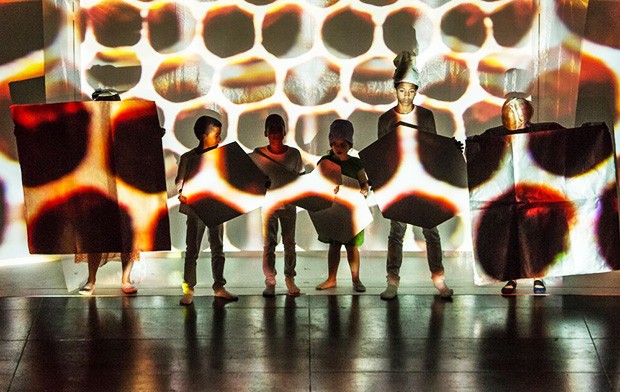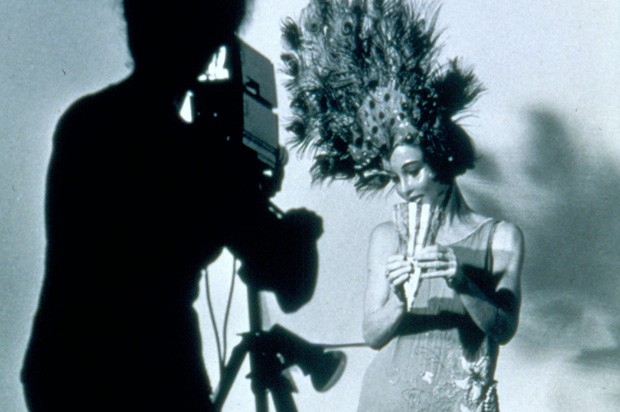5 days focused on research-creation
 “The way we experience aesthetic practices is radically shifting, and putting that into historical context is a really important aspect of the conference," says Christopher Salter. | Images courtesy of Joan Jonas
“The way we experience aesthetic practices is radically shifting, and putting that into historical context is a really important aspect of the conference," says Christopher Salter. | Images courtesy of Joan Jonas
Hexagram’s dedication to disrupting our understanding of how knowledge is produced and the artist’s role in that process has helped put Concordia and its partners at Université du Québec à Montréal (UQAM) at the forefront of the international research-creation revolution.
From November 4 to 8, Hexagram, a research network, hosts the 10th edition of the Media Art Histories (MAH) conference.
The five-day event, Re-Create 2015: Theories, Methods and Practices of Research-Creation in the Histories of Media Art, Science and Technology, will explore the critical role creative practices play in research and knowledge both within and without academia.
Christopher Salter, co-director of Hexagram and Concordia Research Chair in New Media, Technology and the Senses, says it's only appropriate that the Austria-based MAH should hold it's 10th anniversary in Montreal given research-creation's roots in Quebec.
"Research-creation originated in Quebec at the end of the 1990s to describe this intertwining between practice as a particular form of knowledge production in an academic context, and acknowledging that artistic experimentation is critical to that kind of paradigm," he says.
Over the years, the annual meeting has undertaken a critical exploration of the histories of media arts, science and technology and the many ways those fields have merged and mingled.
"The conference looks at the social, technical and political contexts that brought about certain practices, tools, frameworks and ways of knowing, and how we can learn from that," says Salter.
Another key topic at the meeting is the evolving relationship between art and technology and how it contributes to the creation of new narratives and aesthetic experiences.
“The way we experience aesthetic practices is radically shifting, and putting that into historical context is a really important aspect of the conference," says Salter.
Keynote speakers
The role of internal and external influences on the creative process will be the focus of a keynote talk by legendary American visual artist Joan Jonas.
Jonas, who is coming off a recent show at the Venice Art Biennale 2015, will discuss her celebrated career of more than 40 years on November 5, at 8 p.m.
 Joan Jonas, Organic Honey's Vertical Roll, Musée Galliera, Paris, France, 1973. | Photo by Beatrice Helligers
Joan Jonas, Organic Honey's Vertical Roll, Musée Galliera, Paris, France, 1973. | Photo by Beatrice Helligers
"I'll be talking about how work comes from the inside and how it's affected by the outside,” says Jonas. “Those ideas run through my body of work."
"By inside, I mean who you are as an artist, what is your particular expression or approach, and by outside I mean how it relates to the outside world."
There are two other keynote addresses at the conference. Christine Van Assche, honorary curator at the Centre Pompidou in Paris, where she was also chief curator of New Media, will speak on November 6, at 11 a.m.
Canadian Mohawk artist Skawennati, co-director of the research network Aboriginal Territories in Cyberspace, will address participants on November 7, at 11 a.m.
Up-and-coming talent
A new student symposium, taking place today, November 4, highlights emerging works in research-creation.
Cécile Martin, artist and PhD student at Concordia, who is organizing the event, says it gives exposure to graduate work that might otherwise be passed over in favour of more established practitioners in the field.
Twenty student observers will provide live updates and feedback from the main conference via a blog.
"There's a momentum from all these international thinkers who are all interested in the question of research-creation and what it means, and I wanted to engage the audience around this question with the blog," Martin says.
Bigger and more interdisciplinary than ever
Re-Create 2015 is Hexagram’s largest, most ambitious meeting to date.
Eighty-one researchers from 21 countries representing disciplines including digital arts, art history, anthropology, game studies, philosophy and communication will make 53 individual and 13 group presentations.
This emphasis on interdisciplinary dialogue underscores a key contribution of Hexagram and Concordia to the field of research-creation.
"That's what's really interesting about the conference — we're putting together on the same panel makers, thinkers, scholars curators and policy people to mix-up and mess-up that discussion. Research-creation crosses all those traditional divides," Salter said.
For Martin this emphasis on interdisciplinary cooperation is a natural product of the creative environment in Quebec.
"Collaboration is very important to the arts in Quebec. … The sense of collectives, of people who have come together to define their own infrastructure, their own needs and means, this is very strong in the province."
Register for Re-Create 2015: Theories, Methods and Practices of Research-Creation in the Histories of Media Art, Science and Technology.
Check out the schedule of conference events.
American visual artist Joan Jonas’ keynote address takes place on November 5 at 8 p.m. in Room H-110 of the Henry F. Hall Building (1455 De Maisonneuve Blvd. W.) on the Sir George Williams Campus.
Christine Van Assche, honorary curator at the Centre Pompidou in Paris, will speak on November 6 at 11 a.m., in UQAM’s Agora Hydro-Québec, 175 Président-Kennedy Avenue.
Canadian Mohawk artist Shawennati will also address conference participants on November 7 at 11 a.m., in UQAM’s Agora Hydro-Québec.
The Emerging Researchers’ Symposium takes place on November 4 from 9 a.m. to 5 p.m. in UQAM’s Agora Hydro-Québec.